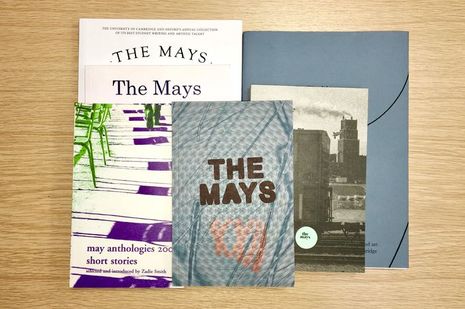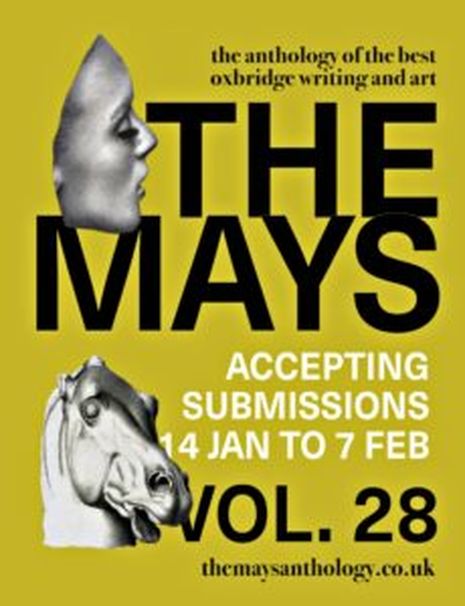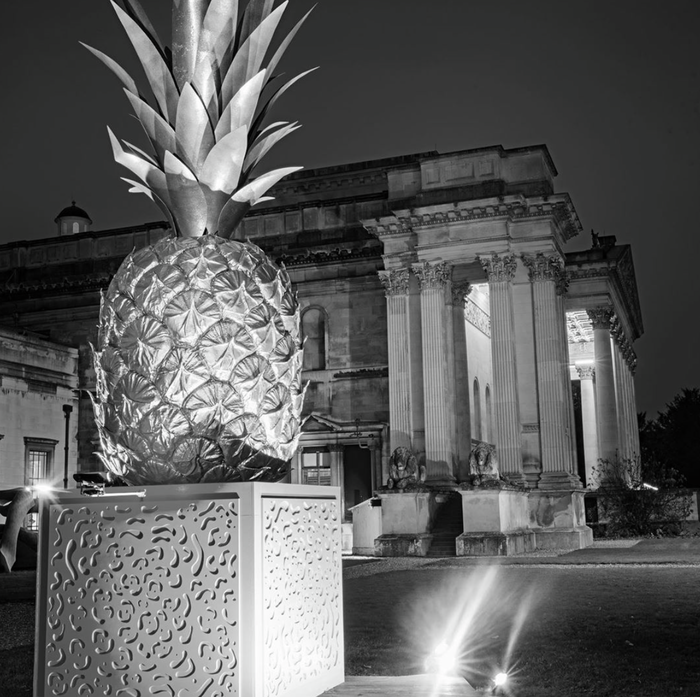The Mays 2020 : More revolutionary than ever
Caterina Bragoli explains why aspiring artists and writers shouldn’t be put off by the anthology’s prestige

Content Note: This article contains discussion of trauma and rape
“Maybe in a few years this lot will have me out of a job,” Zadie Smith famously quipped in the 2001 edition of The Mays, which she guest edited. Smith’s astounding literary career was in fact launched by The Mays, an anecdote the majority of Cambridge students will be familiar with. Employing the same wit that shapes works like White Teeth, her remark feels summative of The Mays: in its showcasing of some of the finest new writing and art from Oxford and Cambridge students, we are treated to a whole host of work that surpasses any preconceived expectations of student writing.
The demystification of the anthology is a priority for this year’s editor, Zoe Matt-Williams, and the entire Mays team
Since its conception in 1992, The Mays has been dedicated to providing a platform for burgeoning writers and artists, taking works that have been archived into notebooks or diaries and showcasing them to a broad readership. It stands firmly amongst the most notable student-produced anthologies, falling into the hands of every major literary agent each year, as well as making its way into bookstores across the country. With a prestigious reputation like this, it is no wonder that The Mays can feel intimidating, or inaccessible: in addition to this, the catalogue of previous guest editors casts a hefty shadow. Patti Smith, Nick Cave and Ted Hughes are just a snapshot of the leading figures hosted by The Mays.

The demystification of the anthology is a priority for this year’s editor, Zoe Matt-Williams, and the entire Mays team. “We’re just keen to hear a variety of voices and genres,” says submissions officer Maya Yousif. The lack of a running theme or specific standpoint means the anthology is open to any and everything, and the only way to make the collaborative project a reflection of Oxford and Cambridge is to represent the variety of students they both hold.
Last year’s anthology, The Mays XXVII, was the most important to date. It tackled some of the most stigmatised yet relevant topics; Joanna Kaye’s After, a prose piece with a mystifying mise-en-page, discusses life after rape. The fragmented arrangement of the prose is reflective of the passing of time after trauma; the process of recovery is not straightforward, but often isolating, perplexing and incomprehensible.
Whether you are a poetry novice or you have reams of paper stashed away, The Mays is the perfect platform to present your work to an eagerly awaiting, literary and art-obsessed audience
The Mays XXVII, for the first time, also included an online supplement of additional material from students, creating an easily accessible digital anthology, and reflecting its constant revolutionary cycle. Some of the rawest work was exhibited using this forum of expression, particularly through photography, illustration and moving imagery. Muhammad Babar Suleman’s Unfeeling: a moving image was the piece that capitvated me the most. The black-and-white aesthetic felt unyielding, stark and stern, especially when juxtaposed against the subject of the moving image: a young man, slowly unfurling his emotional state, reaching breaking point and succumbing to his tears. This heartfelt dedication to male vulnerability in a climate of hypermasculinity (particularly resonant considering the piece was shot in a military-backed institution in Pakistan) was exactly the mode of expression we are seeking to capture within The Mays XXVIII: with an unfiltered, unembellished and unapologetic attitude.
Matt-Williams and the editorial team have acknowledged the power of this newfound digital platform. “This year we’re hoping to place more focus on the visual side of things,” says Matt-Williams, who herself contributed a piece of artwork to the previous year’s anthology. Considering The May’s previous literary-orientated take on showcasing student work, this development is crucial in broadening the range of the anthology, and including as many art forms as possible: after all, it is through visual art, whether paintings or motion picture, that we are able to access candid depictions of real-life emotion.
Whether you are a poetry novice or you have reams of paper stashed away, The Mays is the perfect platform to present your work to an eagerly awaiting, literary and art-obsessed audience. It’s limitless in terms of scope, being defined not by genre or format, but by the submissions received. Constantly revolutionizing itself, the anthology is seeking to include even the most abstract of topics or formats. Contribute to The Mays XXVIII, and play your part in shaping the next anthology of bright new work.
The Mays, Vol. 28 is currently accepting poetry, prose and art submissions until 7 February
 News / Cambridge academics stand out in King’s 2026 Honours List2 January 2026
News / Cambridge academics stand out in King’s 2026 Honours List2 January 2026 Interviews / You don’t need to peak at Cambridge, says Robin Harding31 December 2025
Interviews / You don’t need to peak at Cambridge, says Robin Harding31 December 2025 Comment / What happened to men at Cambridge?31 December 2025
Comment / What happened to men at Cambridge?31 December 2025 Features / “It’s a momentary expression of rage”: reforming democracy from Cambridge4 January 2026
Features / “It’s a momentary expression of rage”: reforming democracy from Cambridge4 January 2026 News / Varsity’s biggest stories of 202531 December 2025
News / Varsity’s biggest stories of 202531 December 2025










